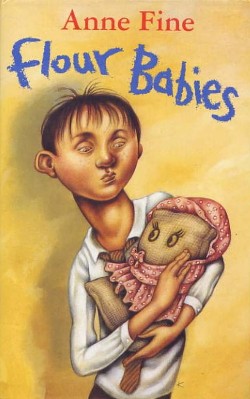Flour Babies facts for kids

First edition
|
|
| Author | Anne Fine |
|---|---|
| Country | United Kingdom |
| Language | English |
| Genre | Children's novel |
| Publisher | Hamish Hamilton |
|
Publication date
|
19 November 1992 |
| Media type | Print (hardcover) |
| Pages | 155 pp (first edition) |
| ISBN | 0-241-13252-5 |
| OCLC | 27149572 |
| LC Class | PZ7.F495673 Fl 1994 |
Flour Babies is a popular book for young people, written by Anne Fine. It was first published in 1992. The story is about a group of students who get a very unusual science project. They have to take care of "babies" made from bags of flour for three weeks! This project helps the main character, Simon, learn a lot about himself and his own family. Many schools use this project to teach students about being responsible.
Anne Fine won a special award called the Carnegie Medal for Flour Babies. This award is given by the Library Association for the best children's book written by a British subject each year. Anne Fine is one of only a few writers who have won this award twice. She also won it in 1986 for her book Goggle-Eyes.
The book was published in the United States in 1994 by Little, Brown. For American readers, some names were changed. For example, the teachers got new names, and the students' classroom changed from "class 4C" to "Room 8."
Contents
What is Flour Babies About?
The story follows a student named Simon Martin. He is in class 4C, which is known for having students who struggle in school. A new student joins the school, and his name is Martin Simon. This is a bit confusing because their names are so similar!
Martin Simon is very good at science and loves to read. He even speaks French. Because he is so smart, he is sent to Dr. Feltham's class. Simon Martin ends up there by accident.
The Science Fair Project
The students in Dr. Feltham's class are choosing projects for the school Science Fair. They really want to work on exciting experiments like "The Exploding Custard Tins" or "Maggot Farm." But these fun projects are only for students who are good at science. So, class 4C is left with some less exciting choices.
They have to pick a topic from options like consumer studies, textiles, child development, nutrition, or domestic economy. Simon Martin is asked to pick a voting slip from a tub. The slip he pulls out says "child development."
The Flour Baby Experiment
Dr. Feltham, who is a bit of an unusual science teacher, has a special experiment for "child development." It's called 'Flour Babies.' Each boy in the class is given a six-pound bag of flour. They wrap the flour in rags to make it look like a baby.
The rule is that each boy must take care of his flour baby all the time, just like it's a real baby. They also have to write a diary about how they manage this big responsibility. The boys are not happy about this project at all, and neither is their regular teacher, Mr. Cartright.
Simon's Discovery
Simon overhears a conversation between Dr. Feltham and Mr. Cartright. He misunderstands what they are saying. Simon thinks that at the end of the project, they will get to kick their flour babies to pieces! Mr. Cartright tries to pick a different topic for the class. But Simon has already told everyone about kicking the babies. The other boys love this idea and convince him to let them do the flour baby experiment.
As the project goes on, Simon starts to really like his flour baby. While the other boys complain, Simon begins to think about his own life. His dad left home when Simon was only six weeks old and never came back. Simon's relationship with his mom has been difficult. Through taking care of his flour baby, Simon starts to understand how hard it can be to be a parent. He learns a lot about responsibility and what it means to care for someone else.

